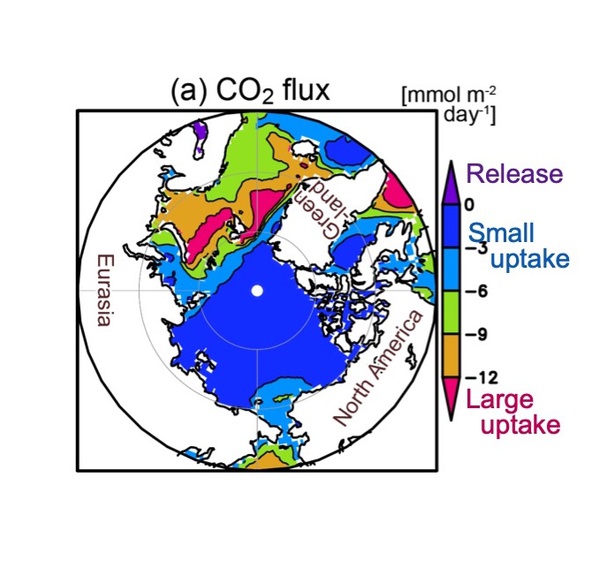Topics 2022.03.08
Arctic Ocean CO2 uptake
Figure 1. CO2 flux averaged for the period of January 1997 to December 2014 (negative values indicate flux into the ocean).
Atmospheric CO2 concentrations have increased since the 19th century. About half of the anthropogenic emissions remain in the atmosphere, and the rest are stored in the oceans and terrestrial biosphere. In other words, thanks to the terrestrial and ocean uptake, CO2 increase in atmosphere is suppressed the present level. The oceans uptake CO2 in average but the uptake is not spatially uniform. Some oceans uptake CO2, while others release. When the ocean CO2 concentration is lower than the atmospheric CO2 concentration, the ocean uptakes CO2 from the atmosphere. Contrarily, the ocean CO2 concentration is higher than the atmospheric CO2 concentration, the ocean releases CO2 to the atmosphere. Stronger winds brings large amount of CO2 exchange. Since sea ice works as a wall between the ocean and the atmosphere, CO2 exchange small when the ocean is extensively covered with sea ice. Accurate estimation of the CO2 budgets is indispensable for prediction of global warming.
The Arctic Ocean is thought to act as a sink for atmospheric CO2 because of the high solubility of CO2 in its low-temperature waters. Furthermore, as global warming progresses, melting of sea ice will increase the area of open water in the Arctic, thus enhancing the potential for the oceanic uptake of CO2 from the atmosphere. So far, spatial and temporal distributions of CO2 flux in the Arctic Ocean had not been well understood due to insufficient data coverage in the heterogeneous area.
To address this issue, we applied a self-organizing map technique, which is a kind of neural network. It finds a relation of sparse CO2 data with enriched satellite data of temperature, sea ice concentration, chlorophyll-a concentration etc., and estimates CO2 flux including the area without CO2 observations. As a result, we produced monthly maps of air-sea CO2 fluxes in the Arctic Ocean for 18 years from January 1997 to December 2014 (Figure 1). These results revealed that annual Arctic Ocean CO2 uptake is 180 ± 130 TgC (1 TgC = 1012 g of carbon = 1 million tons of carbon). It accounts for 10% of the total in the entire ocean, while the Arctic Ocean accounts for only 3% of the world's ocean surface area. In addition, the successful quantification of air-sea CO2 flux in the area also found large spatial and temporal variability. However, we could not detect at this stage which effect exceeds; positive effect by the sea ice retreat and negative effect by the warming.
Sea ice in the Arctic Ocean will continue to retreat. We have to keep our eyes on CO2 change in the Arctic Ocean.
(by Sayaka YASUNAKA, Center for Atmospheric and Oceanic Studies)
Publication
Yasunaka, S., E. Siswanto, A. Olsen, M. Hoppema, E. Watanabe, A. Fransson, M. Chierici, A. Murata, S.K. Lauvset, R. Wanninkhof, T. Takahashi, N. Kosugi, A.M. Omar, S.V. Heuven, J.T. Mathis, Arctic Ocean CO2 uptake: An improved multiyear estimate of the air-sea CO2 flux incorporating chlorophyll a concentrations, Biogeosciences, 15, 1643-1661, 2018.

